|
CONSCRIPTION AND
ENROLMENT |
| |
|
|
17 April 1916 |
Called up for service. |
| |
|
|
27 April 1916 |
Enrolled at York & conscripted to
West Yorkshire Regiment, 10th Battalion. Age given incorrectly
as 22 years, 3 months (correct age: 23 years, 4 months).
Occupation: tailor. Address on enrolment: 9 Badmington (probably
correctly spelt “Badminton”) Terrace, Leeds. |
| |
|
|
POSTING TO FRANCE WITH 10TH BATTALION, WEST YORKSHIRE REGIMENT,
SOUTH-EAST OF ARRAS,
NORTH-EASTERN FRANCE |
|
(as it is
unclear which company of the battalion Morris was in, the entire
battalion’s movements have been gleaned from its war diary) |
| |
|
|
23 August 1916 |
Posted to France as part of
British Expeditionary Force. Assumed that Morris immediately
joined his battalion in the trenches at Hébuterne (Map 1). |
| |
|
| |
|
| |
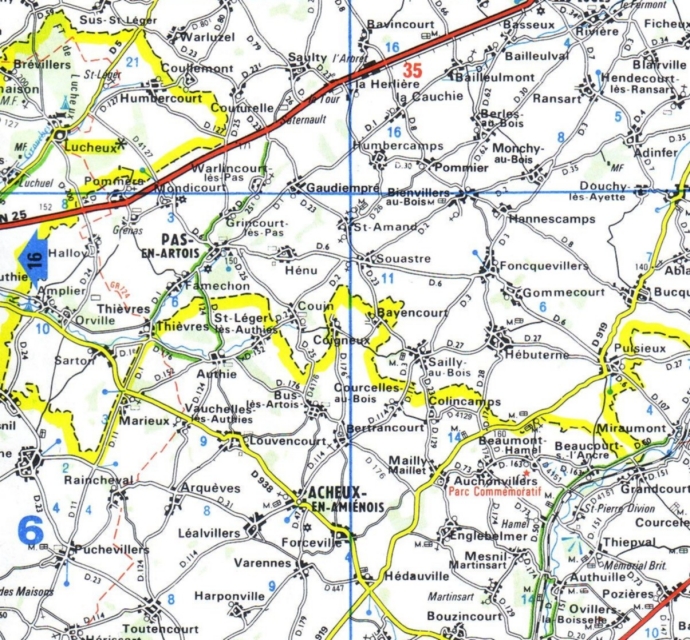 |
|
1. The area south-east of
Arras in which Morris Goodman fought from August 1916 until
February 1917 |
|
|
|
| |
|
| |
|
|
25 August 1916 |
Battalion relieved and moved to
Bayencourt. |
| |
|
|
31 August 1916 |
Battalion back into the trenches
at Hébuterne. Very quiet, with little action from either side. |
| |
|
|
5 September 1916 |
Morris transferred to 1/4th
Battalion of West Riding Regiment (Duke of Wellington’s), then
stationed in Martinsart Wood, following the attack on Thiepval
of 3 September. |
| |
|
| |
|
|
SERVICE WITH 1/4TH BATTALION, WEST RIDING REGIMENT, SOUTH AND
SOUTH-EAST OF ARRAS, NORTH-EASTERN FRANCE |
|
(as it is unclear
which company of the battalion Morris was in, the entire
battalion’s movements have been gleaned from its history and war
diary. He may have been in C Company, based on one of his lists
of offences) |
| |
|
|
7 September 1916 |
Battalion moved to bivouacs near Hedauville by route march. |
| |
|
|
15 September 1916 |
Battalion marched back to Martinsart Wood. |
| |
|
|
16 September 1916 |
Battalion moved to Aveluy in support of attacks by other
battalions of the regiment south of Thiepval (21-24 September in
the front line). |
| |
|
|
24-25 September 1916 |
Battalion moved to Léalvillers for a few hours. |
| |
|
|
25 September 1916 |
Battalion moved on to Halloy. |
| |
|
|
27 September 1916 |
Battalion moved to Humbercamps. |
| |
|
|
28 September 1916 |
Battalion moved on to Bienvillers-au-Bois. |
| |
|
|
29 September 1916 |
Battalion moved to Hannescamps, in the front line. |
| |
|
|
3 October 1916 |
Battalion relieved and moved to Souastre. |
| |
|
|
9 October 1916 |
Battalion returned to front line positions at Hannescamps. |
| |
|
|
16 October 1916 |
Most of battalion moved to Bienvillers-au-Bois in support of the
front line. Part of battalion moved to south of Fonquevillers to
work on tunnels. |
| |
|
|
18 October 1916 |
Battalion reunited at Humbercamps. Very poor accommodation. |
| |
|
|
19 October 1916 |
Battalion moved to St Amand. |
| |
|
|
21 October 1916 |
Battalion moved to Souastre, in Brigade Reserve. |
| |
|
|
24 October 1916 |
Battalion moved into trenches near Fonquevillers, in the front
line. |
| |
|
|
(Plenty of rain and very muddy conditions for several weeks
throughout this period) |
| |
|
|
30 October 1916 |
Battalion marched back to Souastre. |
| |
|
|
5 November 1916 |
Battalion into the trenches. |
| |
|
|
11 November 1916 |
Half of battalion in support at Souastre, while other half in
Fonquevillers. |
| |
|
|
17 November 1916 |
Battalion back into the trenches. |
| |
|
|
23 November 1916 |
Battalion back into Reserve in Souastre. |
| |
|
|
28 November 1916 |
Morris disciplined for irregular
conduct on 26 November. Punishment: 7 days confined to barracks. |
| |
|
|
29 November 1916 |
Battalion back into the trenches. |
| |
|
|
5 December 1916 |
Battalion back to Souastre, then marched to Warlincourt-lès-Pas via St
Amand and Gaudiempre. |
| |
|
|
6 December 1916 |
Battalion moved to Halloy via Grincourt-les-Pas and Pas-en-Artois.
Appalling conditions with plagues of rats. |
| |
|
|
8 December 1916 |
Fined 7 days’ pay for offence on 5 December. |
| |
|
|
(Period of training
and inter-platoon football matches, with working parties sent
out regularly) |
| |
|
|
7 January 1917 |
Half of battalion moved to Berles-au-Bois (via Pas-en-Artois,
Gaudiempre, La Cauchie and Bailleulmont). Other half to
Humbercamps (via Pas-en-Artois, Gaudiempre and La Cauchie). |
| |
|
|
9 January 1917 |
Battalion reunited at Humbercamps. |
| |
|
|
10 January 1917 |
Battalion into the trenches near Berles. Badly constructed and
waterlogged trenches. |
| |
|
|
14 January 1917 |
Battalion moved back to Humbercamps. |
| |
|
|
18 January 1917 |
Battalion into the trenches. |
| |
|
|
22 January 1917 |
Battalion moved back to Berles and Humbercamps. |
| |
|
|
(Very severe frost towards the end of January) |
| |
|
|
26 January 1917 |
Battalion back into the trenches. |
| |
|
|
30 January 1917 |
Battalion returned to Humbercamps. |
| |
|
|
1 February 1917 |
Battalion moved to Rivière via La Cauchie, Bailleulmont and
Basseux. Good accommodation in Brigade Reserve. |
| |
|
|
2 February 1917 |
Battalion into the trenches. Textbook trench system, often used
for training officers. |
| |
|
|
(Plenty of action from both German and British artillery) |
| |
|
|
7 February 1917 |
Battalion back to Rivière itself. |
| |
|
|
11 February 1917 |
Most of battalion back into the trenches, but two platoons of B
Company remained in Rivière. |
| |
|
|
16 February 1917 |
Battalion out of the trenches and back to Rivière. |
| |
|
|
17 February 1917 |
Battalion carried out successful raid against enemy trenches,
involving six officers and 70 men. Morris not among the wounded. |
| |
|
|
20 February 1917 |
Battalion into the trenches. |
| |
|
|
22 February 1917 |
Battalion moved to Bailleulval, into Divisional Reserve. |
| |
|
|
26 February 1917 |
Battalion back into the trenches near Berles. |
| |
|
|
28 February 1917 |
Battalion returned to Bailleulval. Morris believed to have
been one of 10 men wounded during evening shelling of the
village. |
| |
|
|
1 March 1917 |
Battalion moved to Souastre via Bailleulmont, La Cauchie,
Humbercamps and St Amand. |
| |
|
|
2 March 1917 |
Battalion marched to Halloy via Hénu, Pas-en-Artois and Grenas. |
| |
|
|
6 March 1917 |
Battalion moved to Neuvillette (Map 2) via L’Esperance, Lucheux and
Bouquemaison. Excellent accommodation. |
| |
|
| |
|
| |
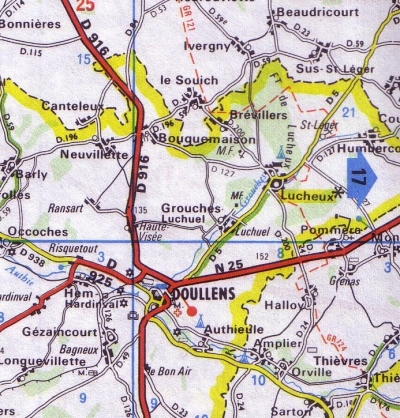 |
|
2. The area around and north
of Doullens, from where
Morris' battalion moved
north-east in early March 1917 |
|
|
|
| |
|
| |
|
|
7 March 1917 |
Battalion marched to Doullens. Night train north to Merville
(approx 40 miles) in
very cold weather. |
| |
|
| |
|
|
SERVICE WITH 1/4TH BATTALION, WEST RIDING
REGIMENT, NORTH-EAST THEN EAST OF BETHUNE, SOUTHERN FLANDERS |
| |
|
| |
|
| |
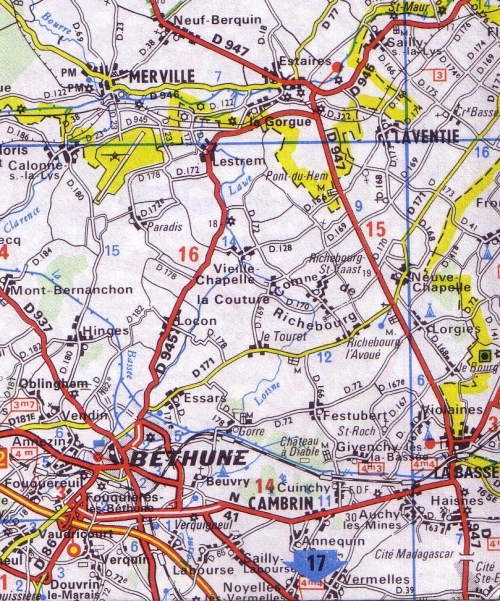 |
|
3. The area north-east of
Bethune, where Morris
fought from early March to the
end of May 1917 |
|
|
|
| |
|
| |
|
|
8 March 1917 |
Battalion arrived in Merville (Map 3) in snowy weather and marched to La
Fosse, north of Vieille Chapelle. Comfortable accommodation. |
| |
|
|
9 March 1917 |
Battalion into Brigade Reserve at and near Senechal Farm, near
Lacouture. |
| |
|
|
13 March 1917 |
Battalion into the trenches in the Ferme-du-Bois sector
south-east of Neuve Chapelle and Fauquisart. |
| |
|
|
(Very quiet period with little German or British activity.
Periods in reserve involved many football matches. Generally
high spirits) |
| |
|
|
17 March 1917 |
Battalion back to Senechal Farm. |
| |
|
|
23 March 1917 |
Battalion back into the trenches. |
| |
|
|
29 March 1917 |
Battalion back to Senechal Farm. |
| |
|
|
4 April 1917 |
Battalion back into the trenches. |
| |
|
|
10 April 1917 |
Battalion back to Senechal Farm. |
| |
|
|
16 April 1917 |
Battalion back into the trenches. |
| |
|
|
22 April 1917 |
Battalion back to Senechal Farm. |
| |
|
|
28 April 1917 |
Battalion back into the trenches. |
| |
|
|
4 May 1917 |
Battalion back to Senechal Farm. |
| |
|
|
(Around this time, several hundred Portuguese Expeditionary
Force troops attached to the battalion to train in front-line
warfare) |
| |
|
|
10 May 1917 |
Battalion back into the trenches. Successful raid against enemy
trenches by one officer and 11 men of B Company. |
| |
|
|
16 May 1917 |
Battalion back to Senechal Farm, back into Brigade Reserve. |
| |
|
|
25 May 1917 |
Battalion marched to Estaires. |
| |
|
|
26 May 1917 |
Battalion marched to Sailly-sur-la-Lys. |
| |
|
|
27 May 1917 |
Battalion into the trenches in the Cordonnerie sector,
south-east of Fleurbaix (Map 4). Numbers very low, around 100, covering
a very long sector of front line. Excellent weather. |
| |
|
| |
|
| |
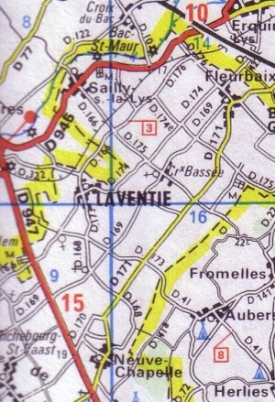 |
|
4. The area
east of Merville, where Morris' battalion was
stationed in early June 1917 |
|
|
|
| |
|
| |
|
|
2 June 1917 |
Successful raid against enemy trenches, involving one officer
and five men, resulting in the capture of seven enemy soldiers.
Morris almost certainly not involved. |
| |
|
|
3 June 1917 |
Battalion moved to Rouge de Bout, east of Laventie, into Brigade
Reserve. |
| |
|
|
11 June 1917 |
Battalion into the trenches. |
| |
|
|
15 June 1917 |
Battalion marched to Estaires. |
| |
|
|
18 June 1917 |
Battalion moved by bus to Sailly Labourse (approx 13 miles),
south-east of Bethune (Map 5). |
| |
|
| |
|
| |
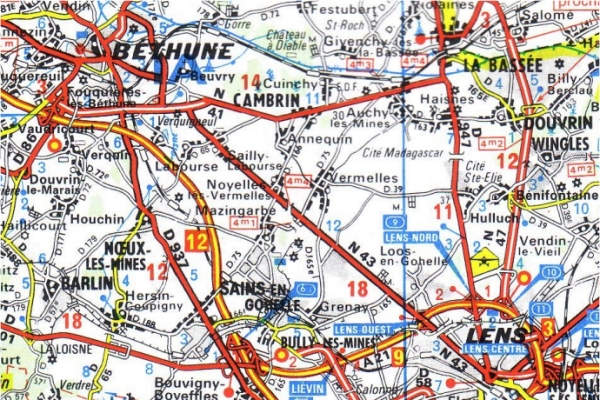 |
|
5. The area between Bethune and
Lens, where Morris' battalion fought during the
second half of June 1917,
sustaining many casualties, especially around Hulluch |
|
|
|
| |
|
| |
|
|
19 June 1917 |
Battalion moved to Philosophe, north-west of Lens. |
| |
|
|
25 June 1917 |
Battalion into the trenches in the St Elie sector, just north of
Hulluch. Very dry trenches in chalk bedrock, well-lit and
well-ventilated. Great deal of German mortar fire. |
| |
|
|
27 June 1917 |
Battalion suffered raid by enemy troops, with six killed, 13
wounded and one taken prisoner. Morris not among these. Raid
followed by enemy attack with gas shells. |
| |
|
|
1 July 1917 |
Battalion moved to Vermelles, in Brigade Reserve. |
| |
|
|
3-4 July 1917 |
Battalion moved by bus from Philosophe to L’Epinette, near
Lestrem, south-east of Merville. Comfortable accommodation and
surroundings. |
| |
|
|
(Period of brigade sports and relaxation) |
| |
|
|
13 July 1917 |
Battalion marched to Merville and moved by train to Dunkerque
(approx 35 miles).
Then marched to new campsite just outside St-Pol-sur-Mer (Map 6). |
| |
|
| |
|
|
SERVICE WITH 1/4TH BATTALION, WEST RIDING
REGIMENT, ON AND NEAR COAST OF NORTHERN FRANCE AND BELGIUM |
| |
|
| |
|
| |
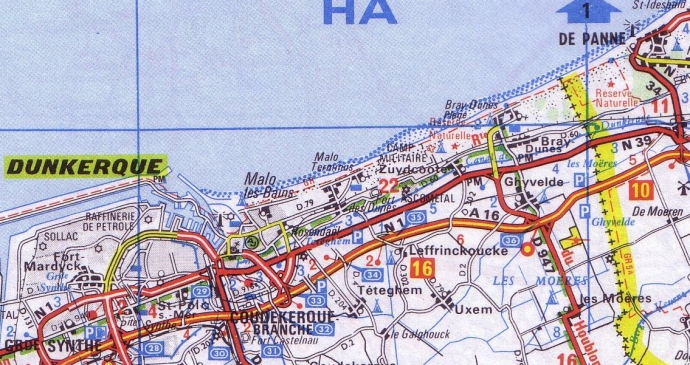 |
|
6. The area of
coast on which Morris' battalion was stationed during July 1917 |
|
|
|
| |
|
| |
|
|
18 July 1917 |
Battalion marched to Bray Dunes. |
| |
|
|
20 July 1917 |
Battalion marched to Ghyvelde. |
| |
|
|
(Period of intensive training) |
| |
|
|
31 July 1917 |
Battalion marched to La Panne Bains (De Panne), a pretty seaside resort
largely unaffected by the war. |
| |
|
|
Night of 3-4 August 1917 |
Battalion moved by bus and route march into the
trenches near Lombartzyde (Lombardsijde, Map 7), south-east of Nieuport
(Nieuwpoort). Heavy rain
and saturated ground. This sector of great strategic importance
and much artillery concentrated on it by both German and Allied
forces. Much enemy shelling. |
| |
|
| |
|
| |
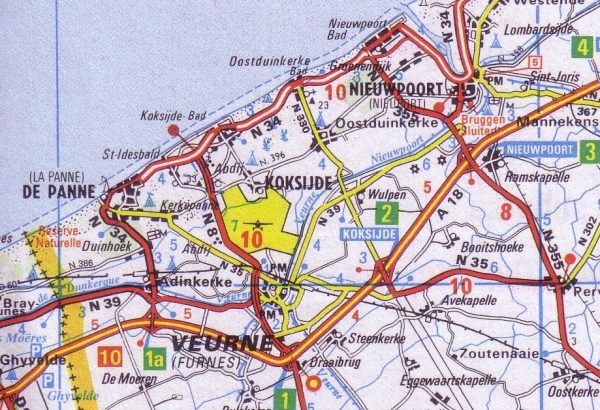 |
|
7. The area around Nieuport,
where Morris endured heavy fighting during August 1917 |
|
|
|
| |
|
| |
|
|
Night of 9-10 August 1917 |
Battalion into Brigade Reserve near Nieuport. |
| |
|
|
13 August 1917 |
Battalion into the trenches near Lombartzyde. |
| |
|
|
Night of 16-17 August 1917 |
Battalion into Brigade Reserve near Oost
Dunkerque (Oostduinkerke), under heavy fire and gas attacks. |
| |
|
|
17 August 1917 |
Battalion marched to Oost Dunkerque Bains (Oostduinkerke Bad). Excellent
accommodation and relaxed atmosphere. |
| |
|
|
27 August 1917 |
Battalion marched to “Surrey Camp”, near Oost Dunkerque Bains. |
| |
|
|
29 August 1917 |
Battalion marched to La Panne. |
| |
|
|
(Period of training and inspection. Battalion came under the
auspices of the Second Army) |
| |
|
|
13 September 1917 |
Battalion marched to Bray Dunes. |
| |
|
|
23 September 1917 |
Battalion marched to Coudekerque. |
| |
|
|
24 September 1917 |
Battalion marched to Wormhoudt (approx 9 miles to the south, Map
8). |
| |
|
| |
|
| |
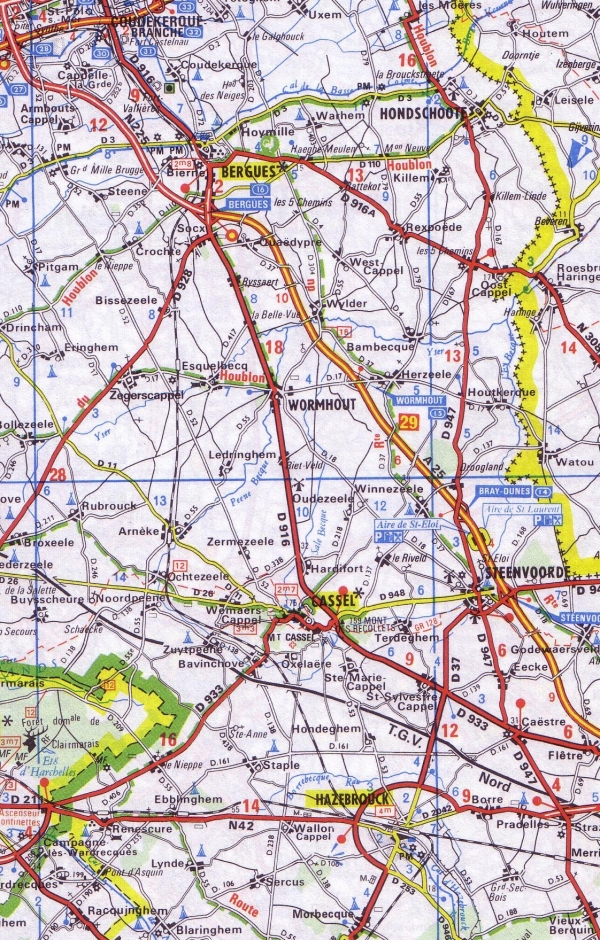 |
|
8. The area of Flanders across
which Morris' battalion marched in late September
1917, in hot conditions, en route
to, and when returning from, Ypres |
|
|
|
| |
|
| |
|
|
25 September 1917 |
Battalion marched to Buysscheure (approx 10 miles to the
south-west). |
| |
|
|
28 September 1917 |
Battalion marched to near Audincthun (approx 20 miles to the
south-west, not shown on above map). |
| |
|
|
30 September 1917 |
Battalion marched to Longue Croix, near Staple, north-east of
Hazebrouck (approx 27 miles to the north-east). |
| |
|
|
3 October 1917 |
Battalion marched to “Clyde Camp”, near Watou, north of
Steenvoorde (approx 14 miles to the north-east). |
| |
|
|
4 October 1917 |
Battalion marched to “Red Rose Camp”, near Vlamertinghe (approx
10 miles to the east), on the western outskirts of Ypres (Ieper, Map 9). |
| |
|
| |
|
| |
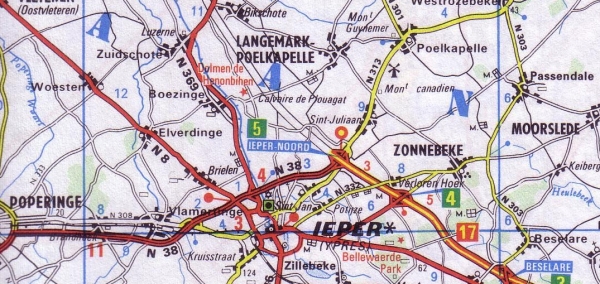 |
|
9. The area
including Ypres (Ieper), Passchendaele (Passendale)
and Poelcapelle (Poelkapelle), where Morris sustained his major injury in
battle on 9 October 1917. |
|
|
|
| |
|
| |
|
|
Night of 4-5 October 1917 |
Battalion moved to Pommern Castle, south of St
Julian (Sint Juliaan). |
| |
|
|
5 October 1917 |
Part of battalion moved to Morbecque (approx 25 miles to the
south-west). |
| |
|
|
Night of 5-6 October 1917 |
Battalion into the trenches near Berlin Wood and
Abraham Heights. |
| |
|
|
Night of 6-7 October 1917 |
Battalion back into Brigade Reserve at Pommern
Castle. |
| |
|
|
9 October 1917 |
Morris wounded at the successful
Battle of Poelcapelle, near Passchendaele. This believed to be
his serious injury. |
| |
|
|
10 October 1917 |
Battalion marched to “X Camp” at St Jean. |
| |
|
|
12 October 1917 |
Battalion in Corps Reserve during the attack on Passchendaele
Ridge, but not called upon. |
| |
|
|
16 October 1917 |
Battalion marched to camp south-east of Vlamertinghe. |
| |
|
|
24 October 1917 |
Battalion moved to “A Camp”, near Winnizeele (Map 8), by bus. |
| |
|
|
27 October 1917 |
Battalion moved to Steenvoorde. |
| |
|
|
1 November 1917 |
Morris returned to England. |
| |
|
| |
|
|
PRESUMED PERIOD OF CONVALESCENCE AT HOME |
| |
|
|
27 July 1918 |
Married Martha Sykes in Holbeck, Leeds. |
| |
|
| |
|
|
HOME SERVICE WITH THE WEST RIDING REGIMENT |
| |
|
|
20 November 1918 |
Posted to unnamed destination (possibly Rugeley, Staffordshire,
possibly with 6th Reserve Battalion). |
| |
|
|
25 January 1919 |
Disciplined for absence 22-24 January. Punishment: 4 days
confined to barracks and forfeit of 3 days’ pay. |
| |
|
|
February 1919 |
Posted to Gateshead? |
| |
|
|
12 February 1919 |
Disciplined for being unshaven on 09:00 parade on 11 February,
______-on-Sea. Punishment: 4 days confined to barracks. |
| |
|
|
14 February 1919 |
Disciplined for absence from Defaulters Roll Call on 13
February, ______-on-Sea. Punishment: 3 days confined to
barracks. |
| |
|
|
29 March 1919 |
Disciplined for absence of 56 hours, 24-27 March, Hale Farm
Prisoner of War Camp, Wendover, Buckinghamshire. Punishment: 10
days confined to barracks. |
| |
|
|
29 April 1919 |
Also at Hale Farm Prisoner of War Camp, disciplined for
overstaying pass 69½ hours, 23-26 April. Punishment: “7 days P
No 2”. |
| |
|
|
8 May 1919 |
Fined one day’s pay for dirty equipment on 09:00 parade that
morning, Leighton Buzzard, Bedfordshire. |
| |
|
|
(date unknown) |
Attached (possibly to 3rd Battalion of 6th Reserves). |
| |
|
|
10 May 1919 |
Ceased attachment to 3rd Battalion. |
| |
|
|
11 May 1919 |
Attached to 65th Protection Company, Royal Defence Corps. |
| |
|
|
26 July 1919 |
Posted to 206th Protection Company, 2nd Battalion, Royal Defence
Corps. |
| |
|
|
3 August 1919 |
Disciplined, possibly for absence on 29 July, possibly in
Pattishull, Northamptonshire. |
| |
|
|
8 August 1919 |
Ceased attachment (possibly to “20th TF”, 2nd Battalion). |
| |
|
|
20 August 1919 |
Admonished for absence of 24 hours, 18-19 August, Pembroke Dock,
South Wales. |
| |
|
| |
|
|
MECHANICS OF DEMOBILISATION |
| |
|
|
17 September 1919 |
Z21 form issued. |
| |
|
|
23 September 1919 |
Z22, D400Z, B103(2), B178 and B120 forms issued. |
| |
|
|
10 October 1919 |
Transferred to Class Z (army reserve on demobilisation), York.
Regiment given as “2 Batt West Riding”. Age given incorrectly as
25 years (correct age: 26 years, 9 months). Address on
discharge: 14 Altoffs Terrace, Leeds. Disabilities: “GSW (i.e.
gunshot wound) left thigh”. Degree of disablement: 30%. This
would later prevent him from having children or sitting down
properly. |